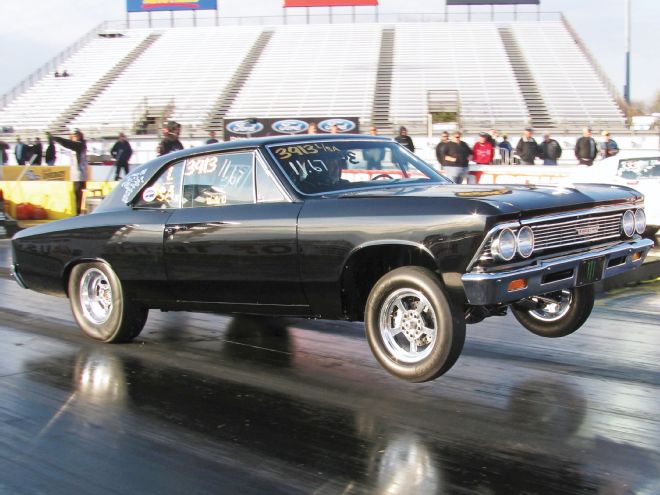
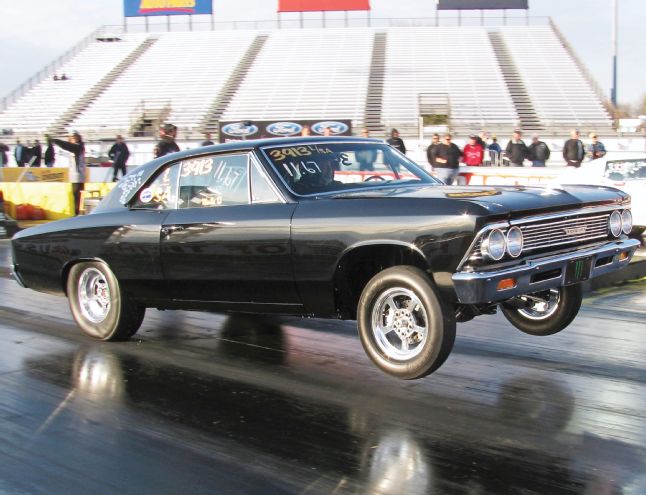
Building an engine for a street performance or bracket race application leaves the builder wide open in terms of parts selection, with power potential only limited by how far you are willing to go and how much you are willing to spend. In NHRA-legal class racing, such as within the ranks of Stock Eliminator, the game rules are strictly defned. The rule book will dictate major parts, from legal major castings to limitations on all manner of engine specifcations. These rules and limitations have their roots in OEM passenger car combinations, as offered by the factory, with mandated use of a variety of OEM components or their legal replacements. As such, a Stock Eliminator competitor must work within these constraints while competing for the prestige of a successful NHRA class racer.
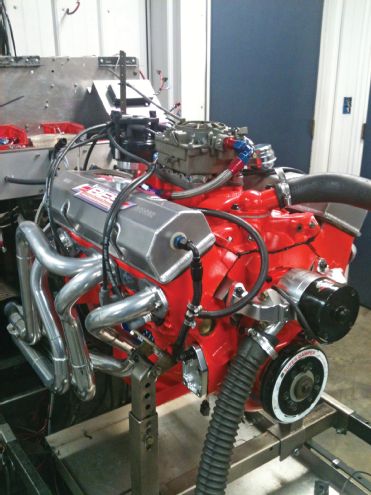 On the dyno at BES, the little engine pumped out 373 hp, a very impressive number considering the small displacement and very restrictive class rules. Constant testing and trying different components is the key to gaining ground in NHRA's tough Stock Eliminator class.
On the dyno at BES, the little engine pumped out 373 hp, a very impressive number considering the small displacement and very restrictive class rules. Constant testing and trying different components is the key to gaining ground in NHRA's tough Stock Eliminator class.
Wade Owens of Cape Girardeau, Missouri, jumped into the highly competitive world of Stock Eliminator running a 283 small-block-equipped '66 Chevelle in L/Stock Automatic. Through honing his skills and refning the small-displacement Chevrolet engine, Wade's combination has become one of the most competitive in the game. What intrigues us about the Stock class cars is the on-track performance and engine power output obtained within the strict rules constraint. A mid-11-seond Chevelle would be an accomplishment to be proud of with a big-inch small-block sporting the latest high-performance parts. What is amazing about a Stock Eliminator car like Wade's is that this level of performance is achieved with a small-displacement engine through stock small-valve OEM heads, a factory iron intake, and the tiny, virtually antique, OEM carburetor.
How is it possible? The name of the game in NHRA Stock racing is an incredible level of refnement in getting the most out of the combination. Testing, optimizing, and thinking outside the box are the hallmarks of a successful effort in this category of racing. On the surface of it, one would be hard pressed to believe that a Stock 283 Chevy, with an actual displacement of 293 cubes, breathing through 1.72-inch intake valves, with lift restricted to a meager 0.399 inch through a stock-style valve train would pull hard to upwards of 8,000 rpm and deliver power approaching 1.3 hp per cubic inch.
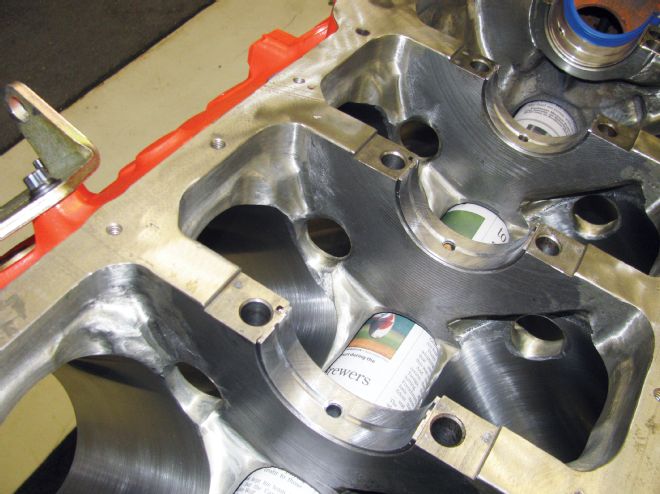 The Bow Tie block gets a tedious makeover in the lower end. Hours are spent smoothing and deburring to cut down on windage. Notice the crankcase pressure balance holes ported into the bottom of the cylinders. They allow the pressure in the cylinders to escape into the next bay, helping with the downstroke motion.
The Bow Tie block gets a tedious makeover in the lower end. Hours are spent smoothing and deburring to cut down on windage. Notice the crankcase pressure balance holes ported into the bottom of the cylinders. They allow the pressure in the cylinders to escape into the next bay, helping with the downstroke motion.
Wade recently had his small-block apart for a freshen-up and contacted us to see if we would be interested in having a look at what's inside. We took that opportunity and detail just what is important in making one of these combinations work. It is no small achievement to put together a competitive combination at a national level in a venue as tough as NHRA Stock Eliminator. With the help of the likes of multiple Amsoil Engine Masters Challenge champion Tony Bischoff of BES Racing and other dedicated professionals, Wade Owens has done just that.
Into the Class Racing Fray
Why would anyone want to run Stock Eliminator? Arguably, the most competitive class in the sportsman ranks, these racers are a special breed. In Stock, you have to use an engine and transmission that was factory available. NHRA designates how much the cars will weigh based on a horsepower factor and shipping weight. Wade Owens relates his introduction to the ranks of Stock Eliminator, "When we frst built the Chevelle, we had no idea it would make a great class car. I had some 283 parts and always liked the '66 Chevelles." Wade and his son, Alex, attended their frst race with the car in 2007. Wade tells us, "It was pretty fast right out of the box. That just stoked us up to see how fast we could really go." And fast they are.
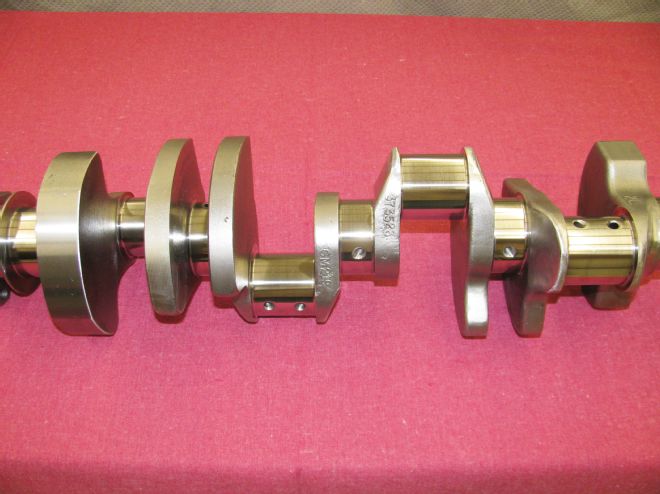 A stock GM crankshaft is required by the strict NHRA rules. Allowed modifications are a normal balance job, a maximum stroke allowance of plus 0.015, shot-peening, and a deburr. The crankshaft in Wade's engine measures 3.013 inches and has had the balance holes welded closed for a smooth counterweight contour.
A stock GM crankshaft is required by the strict NHRA rules. Allowed modifications are a normal balance job, a maximum stroke allowance of plus 0.015, shot-peening, and a deburr. The crankshaft in Wade's engine measures 3.013 inches and has had the balance holes welded closed for a smooth counterweight contour.
The Chevelle currently runs right on or just under the national record. "It takes a lot of work to get the car to run 1 second under the NHRA index. You have to be willing to test everything, then test some more. Sometimes our test sessions are successful, other times, not so much. Carburetors and intake manifolds are not created equal. Casting variances can mean as much as 10 hp difference. It pays to keep your best piece until you get one that shows an e.t. gain." It also pays to surround yourself with a great support team, and Wade is quick to share credit: "Guys like Tony Bischoff of BES, Michael at ICE Ignition, Jeff with Canton Products, and Dean Oliver of Deano's Carburetors have all contributed big to the Chevelle's performance."
As of this writing, the car has garnered eight class wins and six No. 1 qualifying positions and has run as fast as 11.571 in L/Stock Automatic. So what's next? Wade is always contemplating ways of going quicker, "We still have plenty of things that I wonder if it will work. Alex always says it's gotta be worth something!"
VITAL SPECIFICATIONS:
NHRA LEGAL STOCK ELIMINATOR 283 CHEVY
BORE - 3.935 INCHES
STROKE - 3.013 INCHES
DISPLACEMENT - 293.1 CID
COMPRESSION RATIO - 10.6:1
CAMSHAFT - BULLET HYDRAULIC FLAT-TAPPET
CAM DURATION - 258/260 DEGREES AT 0.050
VALVE LIFT - 0.399 INCH
ROCKER ARMS - CRANE BALL PIVOT STAMPED STEEL
ROCKER RATIO - 1.5:1
LOBE SEPARATION - 106 DEGREES
INSTALLED CENTERLINE - 102 DEGREES
TOP RING - TOTAL SEAL 1.2MM GAPLESS
SECOND RING - TOTAL SEAL NAPIER
OIL RING - TOTAL SEAL LOW-TENSION
PISTONS - ROSS STOCK LEGAL
BLOCK - 305 GM BOW TIE
CRANKSHAFT - BULLET GM
CONNECTING RODS - MANLEY 5.7-INCH SMALL JOURNAL
CYLINDER HEADS - GM IRON NO. 520T
INTAKE VALVE DIAMETER - 1.72 INCHES
EXHAUST VALVE DIAMETER - 1.5 INCHES
INTAKE MANIFOLD - GM IRON NO. 459 DUAL-PLANE
CARBURETOR - ROCHESTER 4GC
HEADERS - DENNIS REEVES 15/8-13/4 STEP
IGNITION - ICE IGNITION
DAMPER - ATI
ON THE DYNO
NHRA LEGAL STOCK ELIMINATOR 283 CHEVY
TESTED ON VP C-11 FUEL
TEST AT BES RACING ENGINES